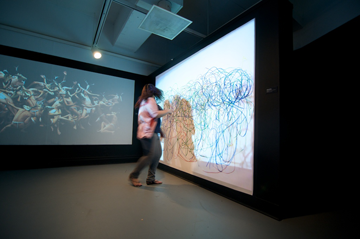Effervescent Condition, curated by Fang-Tze Hsu (MA 2010) was the School of the Art Institute of Chicago’s (SAIC) contribution to The Power of Copying, a large-scale, international group exhibition held at the Xuzhou Museum of Art in Xuzhou, China. With The Power of Copying, curator Qin Jian wished to explore the theme of copying, and how the context of an image or concept, when duplicated, is not steadfast. Jian wished to initiate a debate about the copy and how one’s nationality or ethnic identity informs image and object reproduction, and therefore invited various international pedagogical art institutions to participate.
Fang-Tze Hsu chose a group of artists working with and researching new media, as well as an instructor who is well-versed on the subject matter, to participate in the two concurrent iterations that were her vision for Effervescent Condition; one exhibition was held in Xuzhou Art Museum and the other at The School of the Art Institute of Chicago. The five artists chosen were Nadav Assor, Florian Graf, Adelheid Mers, Joshua Sampson and Wang Yefeng. The exhibition is, for Hsu, a reaction “to the effervescent condition of globalization… [and] the metamorphosis of citizenship under globalization, in which highly skilled, creative individuals are enticed to move freely from one metropolis to the other.”
Walking into SAIC’s Gallery X for the reception, I was immediately struck by Joshua Sampson’s (MFA 2011) Dodgedraw set-up. Utilizing readily available digital technology was highly important to the artist. He constructed real-time, interactive, and simultaneous electronic situations that incorporated the same elements: Skype, a webcam, a projector, markers, and white seamless paper. The digital components were wired so that the web camera recorded the actions and fed it over the Internet in real time via Skype. The Skype video was then translated into life-sized projections onto the seamless paper at both institutions.
The participant in China would frantically work to draw the digital outline of the person in Chicago onto the paper, and vice versa. Both people worked to dodge their counterpart’s attempts to draw them while working to complete their rendering. The result was a time-based, performative, participant-dependent artwork.
According to Sampson, “Dodgedraw focuses on the communication aspect of this exploration and how digital connectivity impacts our physical existence around the globe. This interactive process activates the collapsing of time and space initiated by the widespread implementation of digital communication technologies.”
Observing my friends and colleagues at SAIC attempts to create an outline of the participants at Xuzhou was a frenetic scene of blinding light and markers. Sampson’s ability to engage the audience with Dodgedraw raised one question: What came first, the concept for Effervescent Condition or the concept for Dodgedraw? Does this matter?
Well, it does.
The public has been taught that our participation with a work of art is to stand in front of it and muse on the context of the object that must exist far beyond its aesthetic beauty (or ugliness for that matter). When we peel away the object, we are left with an artist’s concept or abstract idea, which can be liberating for some and downright challenging for others.
Which brings me to an embarrassing anecdote: last fall, The Renaissance Society mounted a solo exhibition of work by Allan Sekula. Polonia and Other Fables consisted of large-scale photographs the artist had taken in Chicago and Poland. The work itself was arranged into smaller, non-explicit narratives, supported by text written by Sekula. The only didactic material in the exhibition were a few laminated checklists placed on tables that were towards the back of the room. As I approached the entrance with a few classmates, I asked Hamza Walker, Director of Education at the Renaissance Society, “Where do I start?” He laughingly responded, “Wherever you want!” Well, of course…I had gotten so used to an implied exhibition narrative that I had temporarily forgotten how to construct my own experience.
It was that moment where my sudden and overly conscious attention to the ways that institutions entice the viewer to interact more closely with artwork began. This over-consciousness soon became a small obsession — mainly with experimental ways of accessibility and interaction — which has steamrolled into gathering analytics from cell phone calls to audio tours programmed into a storefront exhibition space, and brainstorming on how to organize an exhibition that consists mainly of QR Codes.
This explains why I always wanted to have a more tactile experience with a work of art. I need not the spectacle (although it is mesmerizing at times) but to engage and be engaged with a concept in a more exploratory way. Point being…interactivity is a crucial element of experiencing art.
Allison Glenn is getting a dual MA in Modern Art History, Theory and Criticism + Arts Administration and Policy at the School of the Art Institute of Chicago and is Project Manager in the Office of Exhibition Practices.